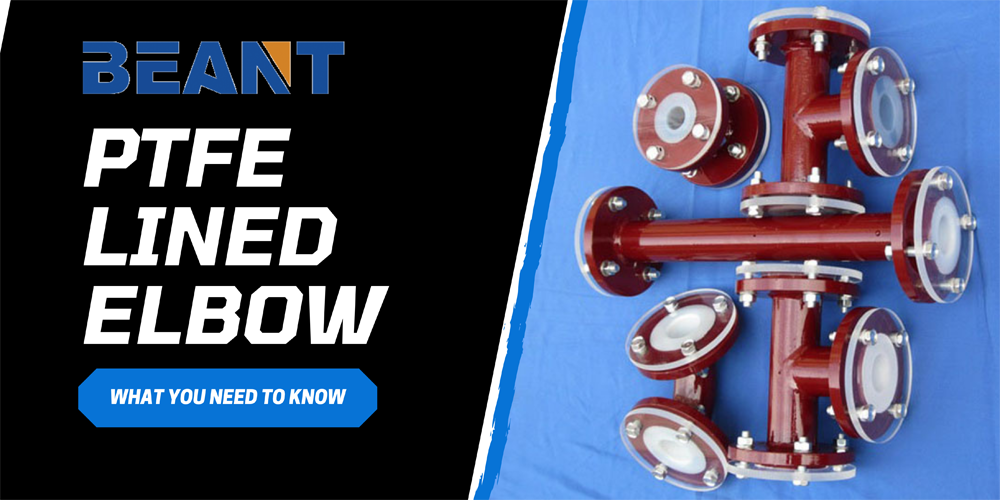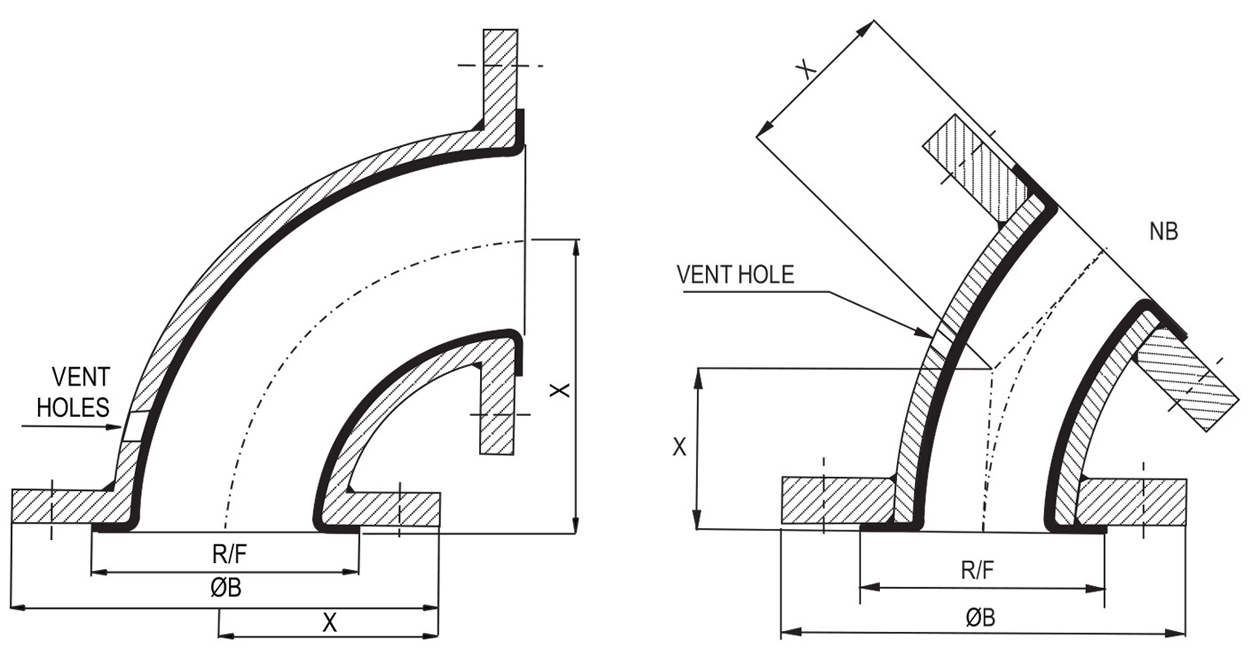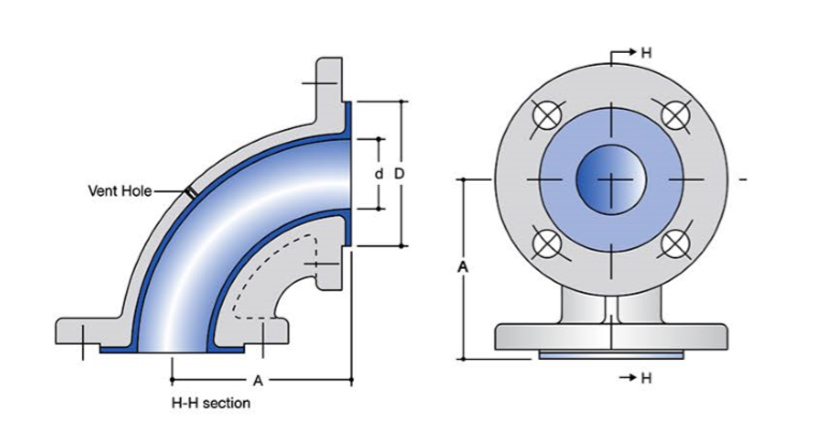
Polytetrafluoroethylene (PTFE), a synthetic fluoropolymer of tetrafluoroethylene, is renowned for its exceptional resistance to heat, chemicals, and corrosion. PTFE lined elbows are a critical component in piping systems across various industries, providing essential protection and enhancing longevity. These fittings allow for secure connections between pipes with the added benefits of PTFE’s properties, ensuring smooth flow of highly corrosive or high-purity substances without compromising the integrity of the pipeline.
The manufacturing of PTFE lined elbows is a sophisticated process that combines advanced engineering with specialized materials. The process involves several key steps to ensure that the final product delivers exceptional performance in demanding environments.
The first step is selecting high-quality PTFE and steel. PTFE is chosen for its outstanding chemical resistance and thermal properties, while the steel is typically a high-grade stainless or carbon steel, providing the necessary mechanical strength.
The PTFE liner is initially formed as a paste. It is then carefully applied to the inner surface of the steel elbow. This paste must be uniformly spread to prevent any gaps or weak spots, ensuring the liner will hold up under operational pressures.
After pasting, the lined elbow undergoes a molding process to shape the PTFE according to the elbow's dimensions. The sintering process follows, where the assembly is heated to high temperatures. This step causes the PTFE to bond strongly to the steel and solidify into a seamless, robust lining.
Post-sintering, the elbow is allowed to cool at a controlled rate to prevent the formation of stress cracks. Each elbow is then inspected rigorously to ensure it meets all specifications for thickness, diameter, and integrity of the lining.
Finally, any additional components, such as flanges or fittings, are attached. The completed elbow is then subjected to various tests, including pressure tests and leak tests, to certify its performance and durability.
Table 1: Key Properties of Materials Used in PTFE Lined Elbows
| Material | Properties | Benefits |
| PTFE | High chemical resistance, non-stick | Suitable for corrosive substances |
| Stainless Steel | High strength, corrosion-resistant | Provides structural integrity |
| Carbon Steel | High strength, cost-effective | Economical for large-scale use |
Understanding the differences between PTFE lined elbows and other types of lined elbows can help you make informed decisions regarding which is best suited for your specific applications. This comparison focuses on performance, durability, and cost-effectiveness.

PTFE lined elbows often outperform their counterparts due to PTFE's superior chemical resistance, which makes them ideal for handling aggressive chemicals. Unlike rubber or polyethylene lined elbows, PTFE does not degrade easily under extreme conditions.
The lifespan of PTFE lined elbows generally surpasses that of other linings like rubber, which can perish and degrade under varying temperatures and chemical exposures. PTFE's inert nature and resistance to UV light and weathering contribute to its durability, making it a cost-effective option in the long run.
While PTFE lined elbows might have a higher initial cost compared to rubber or polyethylene linings, their longevity and lower maintenance requirements render them more economical over time. Reduced downtime and less frequent replacements mean better overall value.
Table 2: Performance Comparison of Lined Elbows
| Lining Type | Chemical Resistance | Temperature Range | Expected Lifespan |
| PTFE | Excellent | -200 to +260°C | Very High |
| Rubber | Moderate | -50 to +150°C | Moderate |
| Polyethylene | Good | -50 to +80°C | Low to Moderate |
Proper installation of PTFE lined elbows is crucial for ensuring their optimal performance and longevity. These tips are designed to help technicians and engineers install these components correctly and safely.
Before installation, ensure all piping and components are clean and free from debris. Inspect the PTFE lined elbows for any signs of damage or imperfections. Any defects should be addressed before proceeding.
Carefully align the PTFE lined elbows with the piping system to avoid any stress or strain on the fittings. Misalignment can lead to premature wear or even failure under pressure.
Use appropriate gaskets and bolts for connections. Over-tightening can damage the PTFE lining, so it is essential to follow the specified torque settings. Always check the manufacturer’s recommendations.
If welding near the lined elbow, protect the PTFE from excessive heat, as it can degrade at high temperatures. Use insulation or cooling methods to shield the lining during the welding process.
After installation, perform a thorough inspection to ensure there are no leaks. Pressure testing the system is recommended to verify the integrity of all connections.
Regular maintenance and proper care are essential for maximizing the lifespan and efficiency of PTFE lined elbows. These guidelines will help ensure your elbows remain in top condition, minimizing the likelihood of system failures.

Regularly inspect your PTFE lined elbows for signs of wear, corrosion, or damage. Visual inspections should be comprehensive, looking for any discoloration, deformation, or cracks in the lining.
Clean the PTFE lined elbows according to the manufacturer’s guidelines. Generally, mild cleaning agents are recommended to avoid damaging the PTFE lining. Harsh chemicals should be avoided unless specified as safe for PTFE.
If any damage is detected during inspections, address it immediately. Small issues, such as minor leaks or wear, can quickly escalate into more significant problems if not corrected promptly.
Follow the manufacturer’s recommended replacement schedules. While PTFE lined elbows are durable, they are not indestructible and will require replacement eventually, particularly in high-stress or corrosive environments.
Maintain records of all inspections, cleanings, and repairs. Good documentation can help track the performance over time and identify when replacements are necessary, ensuring the safety and reliability of your system.
Table 3: Maintenance Schedule for PTFE Lined Elbows
| Frequency | Task | Notes |
| Monthly | Visual inspection | Check for any visible signs of wear |
| Every 6 months | Detailed inspection | Include pressure testing |
| As needed | Cleaning | Follow specific guidelines for PTFE |
| Annually | Review maintenance records | Adjust maintenance schedule as necessary |
PTFE lined elbows are indispensable in industries requiring highly durable and chemical-resistant piping solutions. From their meticulous manufacturing process to the detailed care they require, these components are designed to offer superior performance under challenging conditions. By understanding the advantages of PTFE lined elbows over other types, and by following proper installation and maintenance practices, you can ensure the longevity and reliability of your fluid handling systems.
Adhering to the guidelines and schedules for maintenance will not only prolong the life of these fittings but also optimize their functionality, preventing costly downtime and repairs. As we have explored in this guide, the initial investment in PTFE lined elbows is worthwhile, considering the extensive benefits they provide in terms of durability, resistance, and overall cost-effectiveness.
Feel free to leave your message on our board. If you're looking to inquire about prices or place an order, this is the right place! Let us know the details of your needs, and our team will get back to you with a personalized quote as quickly as possible. We're here to ensure your experience is seamless and satisfactory. Share your requirements or ask any questions you might have - we're eager to assist and look forward to doing business with you!
Name:Tim
Phone:+86-15716151880
Email:[email protected]
Company:BEANT
Address:No. 28, Luoshen Road, Luoshe Town, Huishan District, Wuxi City, Jiangsu Province
